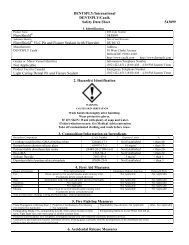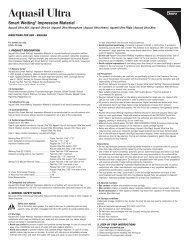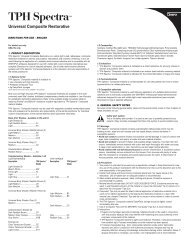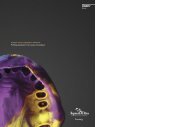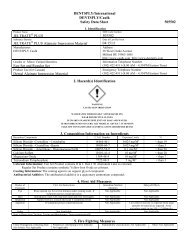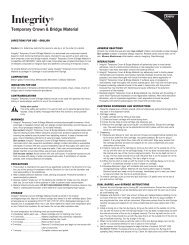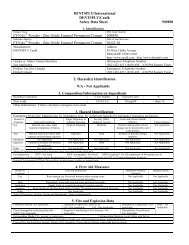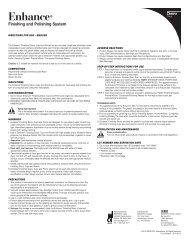Indirect and Direct Restorative Protocols - Caulk
Indirect and Direct Restorative Protocols - Caulk
Indirect and Direct Restorative Protocols - Caulk
Create successful ePaper yourself
Turn your PDF publications into a flip-book with our unique Google optimized e-Paper software.
››“The Midwest metal-cutting burs have made<br />
removal of old crowns a quicker, less stressful<br />
experience, <strong>and</strong> they efficiently cut through whatever<br />
metal is used to fabricate the restoration.”<br />
Gregori M. Kurtzman, DDS<br />
Private practice, Silver Spring, MD.<br />
Figure 3. Cross-section view of the divergent walls, created with the tapered,<br />
round-end bur (MultiPrep, DENTSPLY Professional, York, PA),<br />
for the cavity preparation.<br />
Figure 4. Straight, flat-end burs can be utilized to finalize the walls <strong>and</strong><br />
floor of the preparation. Tapered burs create divergent walls with<br />
rounded internal line angles.<br />
Table. Tracking Individual Bur Usage<br />
It is important to track use on a bur-by-bur basis to reduce<br />
premature disposal or overuse of burs. Overuse may<br />
result in:<br />
■■ Instrument separation;<br />
■■ Excessive heat generation;<br />
■■ Damage to the h<strong>and</strong>piece; <strong>and</strong><br />
■■ Potential patient injury.<br />
Sterilization is also critical using a Cresent® Germicide Tray (DENTSPLY<br />
Rinn, Elgin, IL) <strong>and</strong> Bur Caddy / Bur Block (DENTSPLY Professional,<br />
York, PA) to safely disinfect bur systems with glutaraldehyde- <strong>and</strong><br />
phenol-based disinfectants. These caddies allow burs to be:<br />
■■ Individually sterilized;<br />
■■ Cleansed using a h<strong>and</strong>s-free approach to prevent<br />
contamination;<br />
■■ Kept separate from other burs in the kit; <strong>and</strong><br />
■■ Easily restocked following autoclaving.<br />
a bur <strong>and</strong> torque speed that will remove<br />
the existing restoration without<br />
impinging on the underlying tooth<br />
structures (Figure 2). Copious irrigation<br />
is also paramount to keeping the<br />
bur cool, prolonging its use (Table),<br />
<strong>and</strong> improving its cutting efficiency. It<br />
also ensures that the clinician can view<br />
the structures being removed, thereby<br />
reducing the potential for excessive<br />
tooth reduction. Once the preexisting<br />
restoration <strong>and</strong> carious structures have<br />
been removed, it is imperative to create<br />
divergent angles to facilitate retention<br />
of the definitive indirect restoration or<br />
convergent preparation walls to retain<br />
the restoration (Figure 3). Application<br />
of a cross-cut bur should only be implemented<br />
if additional gross reduction<br />
is required for extensive preparation<br />
designs (Figure 4). Once the desired<br />
preparation design has been achieved,<br />
the burs should be cleaned <strong>and</strong> carefully<br />
returned to the bur kit. n<br />
8



